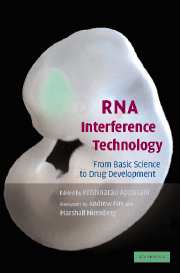Book contents
- Frontmatter
- Contents
- Foreword by Andrew Fire
- Foreword by Marshall Nirenberg
- List of Contributors
- Introduction
- Section one Basic RNAi, siRNA, microRNAs and gene-silencing mechanisms
- Section two Design, synthesis of siRNAs
- Section three Vector development and in vivo, in vitro and in ovo delivery methods
- 10 Six methods of inducing RNAi in mammalian cells
- 11 Viral delivery of shRNA
- 12 siRNA delivery by lentiviral vectors: Design and applications
- 13 Liposomal delivery of siRNAs in mice
- 14 Chemical modifications to achieve increased stability and sensitive detection of siRNA
- 15 RNA interference in postimplantation mouse embryos
- 16 In ovo RNAi opens new possibilities for functional genomics in vertebrates
- Section four Gene silencing in model organisms
- Section five Drug target validation
- Section six Therapeutic and drug development
- Section seven High-throughput genome-wide RNAi analysis
- Index
- Plate section
- References
16 - In ovo RNAi opens new possibilities for functional genomics in vertebrates
Published online by Cambridge University Press: 31 July 2009
- Frontmatter
- Contents
- Foreword by Andrew Fire
- Foreword by Marshall Nirenberg
- List of Contributors
- Introduction
- Section one Basic RNAi, siRNA, microRNAs and gene-silencing mechanisms
- Section two Design, synthesis of siRNAs
- Section three Vector development and in vivo, in vitro and in ovo delivery methods
- 10 Six methods of inducing RNAi in mammalian cells
- 11 Viral delivery of shRNA
- 12 siRNA delivery by lentiviral vectors: Design and applications
- 13 Liposomal delivery of siRNAs in mice
- 14 Chemical modifications to achieve increased stability and sensitive detection of siRNA
- 15 RNA interference in postimplantation mouse embryos
- 16 In ovo RNAi opens new possibilities for functional genomics in vertebrates
- Section four Gene silencing in model organisms
- Section five Drug target validation
- Section six Therapeutic and drug development
- Section seven High-throughput genome-wide RNAi analysis
- Index
- Plate section
- References
Summary
Introduction
The development of high-throughput methods has changed the way genes are analyzed. In the past, a spontaneous or targeted mutation was a prerequisite for the identification of a gene and its function. Today, genome-sequencing projects and large-scale screens provide a tremendous amount of information about the genetic make-up of an organism. Unfortunately, the long lists of genes expressed in specific tissues or distinct phases of an organism's life provide little or no information about the function of the expressed proteins. Functional gene analysis remains a time-consuming and challenging step that requires changes in gene expression in the context of a living organism. Therefore, the availability of suitable model systems is key to our progress in understanding the role of genes in biological processes. Model systems need to be easily accessible and efficient in producing functional read-outs of gene manipulation. Due to constraints in time and money these criteria were met only by invertebrate animal models, such as Drosophila and C. elegans (Adams and Sekelsky, 2002; St. Johnston, 2002; Lee et al., 2003; Simmer et al., 2003). For many studies, however, vertebrate model systems are required. The mouse has been the most widely used vertebrate model system, because technologies for genetic manipulations based on homologous recombination in embryonic stem cells are available and allow for selected inactivation of target genes (Porter, 1998; Müller, 1999; Jackson, 2001).
- Type
- Chapter
- Information
- RNA Interference TechnologyFrom Basic Science to Drug Development, pp. 220 - 232Publisher: Cambridge University PressPrint publication year: 2005
References
- 2
- Cited by



